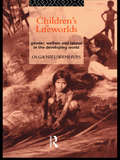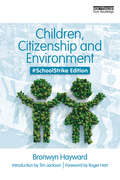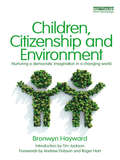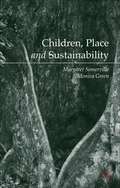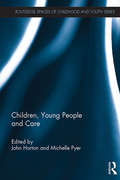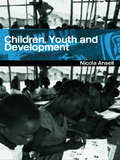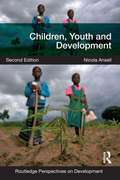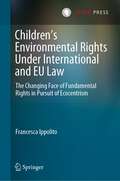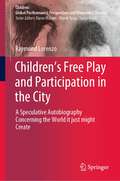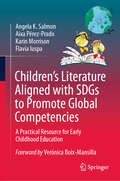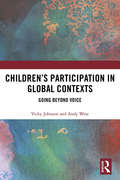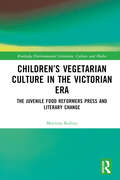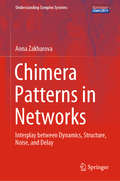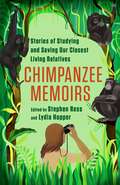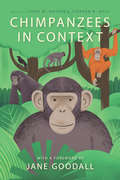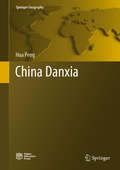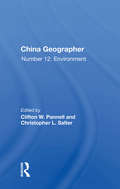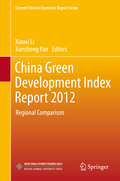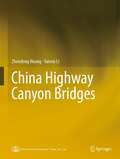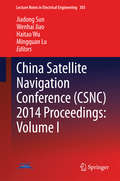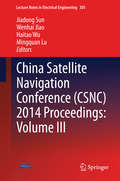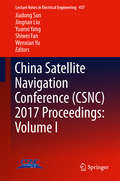- Table View
- List View
Children's Lifeworlds: Gender, Welfare and Labour in the Developing World
by Olga NieuwenhuysChildren's Lifeworlds examines how working children face the challenge of having to combine work with school in Kerala. Moving beyond the usual concern with child labour and welfare to a critical assessment of the daily work routine of children, this book questions how class and kinship, gender and household organization, state ideology and education influence and conceal the lives of children in developing countries. Presenting an extraordinarily sympathetic and detailed case study of boys' and girls' work routine in a south Indian village, this book shows children creating the visibility of their work. The combination of personal experience, quantitative data and in-depth anthropological methods, sheds light on the world of those who, though they hold the future, have been left in the dark.
Children, Citizenship and Environment: #SchoolStrike Edition
by Bronwyn HaywardIn this significantly revised second edition of Bronwyn Hayward’s acclaimed book Children Citizenship and Environment, she examines how students, with teachers, parents, and other activists, can learn to take effective action to confront the complex drivers of the current climate crisis including: economic and social injustice, colonialism and racism. The global school strikes demand adults, governments, and businesses take far-reaching action in response to our climate crisis. The school strikes also remind us why this important youthful activism urgently needs the support of all generations. The #SchoolStrike edition of Children Citizenship and Environment includes all new contributions by youth, indigenous and disability activists, researchers and educators: Raven Cretney, Mehedi Hasan, Sylvia Nissen, Jocelyn Papprill, Kate Prendergast, Kera Sherwood O’ Regan, Mia Sutherland, Amanda Thomas, Sara Tolbert, Sarah Thomson, Josiah Tualamali'i, and Amelia Woods. As controversial, yet ultimately hopeful, as it was when first published, Bronwyn Hayward develops her ‘SEEDS’ model of ‘strong ecological citizenship’ for a school strike generation. The SEEDS of citizenship education encourage students to develop skills for; Social agency, Environmental education, Embedded justice, Decentred deliberation and Self-transcendence. This approach to citizenship supports young citizens’ democratic imagination and develops their ‘handprint’ for social justice. This ground-breaking book will be of interest to a wide audience, in particular teachers and professionals who work in Environmental Citizenship Education, as well as students and community activists with an interest in environmental change, democracy and intergenerational justice.
Children, Citizenship and Environment: Nurturing a Democratic Imagination in a Changing World
by Bronwyn HaywardChildren growing up today are confronted by four difficult and intersecting challenges: dangerous environmental change, weakening democracies, growing social inequality, and a global economy marked by unprecedented youth unemployment and unsustainable resource extraction. Yet on streets everywhere, there is also a strong, youthful energy for change. This book sets out an inspiring new agenda for citizenship and environmental education which reflects the responsibility and opportunities facing educators, researchers, parents and community groups to support young citizens as they learn to 'make a difference' on the issues that concern them. Controversial yet ultimately hopeful, political scientist Bronwyn Hayward rethinks assumptions about youth citizenship in neoliberal democracies. Her comparative discussion draws on lessons from New Zealand, a country where young citizens often express a strong sense of personal responsibility for their planet but where many children also face shocking social conditions. Hayward develops a 'SEEDS' model of ecological citizenship education (Social agency, Environmental Education, Embedded justice, Decentred deliberative democracy and Self transcendence). The discussion considers how the SEEDs model can support young citizens' democratic imagination and develop their 'handprint' for social justice. From eco-worriers and citizen-scientists to streetwise sceptics, Children, Citizenship and Environment identifies a variety of forms of citizenship and discusses why many approaches make it more difficult, not easier, for young citizens to effect change. This book will be of interest to a wide audience, in particular teachers of children aged eight to twelve and professionals who work in Environmental Citizenship Education as well as students and researchers with an interest in environmental change, democracy and intergenerational justice. Introduced by Tim Jackson, author of Prosperity without Growth, the book includes forewords by leading European and USA academics, Andrew Dobson and Roger Hart. Half the author's royalties will be donated to child poverty projects following the earthquakes in Christchurch, New Zealand. Follow Bronwyn Hayward's blog at: http://growing-greens.blogspot.co.nz/See Bronwyn Hayward discuss the book at: http://www.youtube.com/watch?v=kptEw1aZXtM&feature=youtu.be
Children, Place and Sustainability
by Margaret Somerville Monica GreenThrough focusing on children's sustainability learning this book examines how school education can address the current environmental problems. It explores children's responses in literacy and language, arts-based approaches, and indigenous studies as well as scientific pedagogies to provide a unique insight into how children learn.
Children, Young People and Care (Routledge Spaces of Childhood and Youth Series)
by John Horton Michelle PyerThe very notions of childhood and youth are intimately connected to contemporary norms, practices and spaces of care, caring and care-giving. The provision of care is widely figured as both the primary responsibility of parents, carers and practitioners who work with children and young people, and the primary factor in shaping children and young people’s development, education, socialisation, wellbeing and contentment. However, children and young people themselves are rarely figured as key actors in the provision of care. An overwhelming presumption that children and young people are to be cared for has effectively marginalised their agency and responsibilities as carers, or in relation to practices and spaces of care. Bringing together a significant array of multidisciplinary work on children, young people and families, this collection draws together new research on the diverse lives and experiences of children and young people as carers, as cared for, and in relation to spaces and institutions of care. It is the first collection specifically devoted to the subject of care in relation to childhood and youth. As such, the book will be a key resource for academics, practitioners and students seeking leading-edge empirical and conceptual material on this topic.
Children, Youth and Development
by Nicola AnsellChildren constitute a large part of the population of developing countries. Throughout the developing world, experiences of childhood are extremely diverse, both between places and between children in particular places, from the international level through to the different treatment of a boy and a girl within the same household. This informative book considers issues such as education, child labour, street children, child soldiers, refugees, child slaves, the impact of environmental change and hazards on children and the way that children, with the enthusiasm and energy to bring about change, can be enabled to participate in 'development'.
Children, Youth and Development (Routledge Perspectives on Development)
by Nicola AnsellThe new updated edition of Children, Youth and Development explores the varied ways in which global processes in the form of development policies, economic and cultural globalisation, and international agreements interact with more locally specific practices to shape the lives of young people living in the poorer regions of the world. It examines these processes, and the effects they have on young people’s lives, in relation to developing theoretical approaches to the study of children and youth.? This landmark title brings together the stock of knowledge and approaches to understanding young people’s lives in the context of development and globalization in the majority world for the first time. It introduces different theoretical approaches to the study of young people, and explores the ways in which these, along with predominantly Western conceptions of childhood and youth, have influenced how majority world children have been viewed and treated by international agencies. Contexts of globalisation and growing international inequality are explored, alongside more immediate contexts such as family and peer relationships. Chapters are devoted to groups of children deemed to be in need of protection and to debates concerning children’s rights and their participation in development projects. Young people’s health and education are considered, as is their involvement in work of various kinds, and the impacts of environmental change and hazards (including climate change). The book introduces material and concepts to readers in a very accessible way and within each chapter employs features such as boxed case studies, summaries of key ideas, discussion questions and guides to further resources. This edition has been updated to take account of significant changes in the contexts in which poor children grow up, notably the financial crisis and changing development policy environment, as well as recent theoretical developments. It is aimed at students on higher level undergraduate and postgraduate courses, as well as researchers who are unfamiliar with this area of research and practitioners in organisations working to ameliorate the lives of children in majority world countries.
Children’s Environmental Rights Under International and EU Law: The Changing Face of Fundamental Rights in Pursuit of Ecocentrism
by Francesca IppolitoThis book is dedicated to a topic which has for a long time lacked the attention it deserves within the academic world. It intends to address in a coherent and comprehensive manner the problem of the environmental rights of the child, which are not identical to the ones of adults whose environmental rights have been appraised from a general point of view. In the absence of any international law instrument explicitly granting a child the right to a clean environment, drawing on an extensive and original analysis of the UN Convention on the Rights of the Child and the practice of its monitoring body, this book undertakes an assessment of the extent to which these challenges may be overcome through a greater engagement between international law on the rights of the child and international environmental law. The result is the first comprehensive study on the manner in which these two mutually reinforcing legal regimes can interact to strengthen the protection of children’s environmental human rights at stake in the increased strategic environmental and climate litigations at both the national and international level. The book is recommended reading for, amongst others, policy makers, international environmental lawyers and human rights lawyers and practitioners. Additionally, lecturers, students and researchers from a range of disciplines will also gain from seeing how new legal scholarship and intertwined branches of international law contribute to the continual development of the living rights of the human rights conventions. Francesca Ippolito is Associate Professor of International Law in the Department of Political and Social Science of the University of Cagliari, Italy. She holds the Jean Monnet Chair on European Climate of Change - REACT for 2021-2024.
Children’s Free Play and Participation in the City: A Speculative Autobiography Concerning the World it just might Create (Children: Global Posthumanist Perspectives and Materialist Theories)
by Raymond LorenzoThis book presents an interplay of imaginative memoir-telling, action research data and future projection that reminds and inspires experiences academics, researchers, professionals, as well as a wider public to recognize the fundamental importance and the impellent need for more and better work in favour of true political and societal recognition of the needs and rights of children to play freely, to participate, to live fully and enjoy their neighbourhoods and cities, and to imagine and construct alternative futures, together with adults. The book's abundant spoken dialogue is, in effect, storytelling between children (and youth) on their own and with adults (especially the elderly). It conveys an appreciation of children’s special capacities to think critically about their everyday places—and the greater world around them—and to develop solutions (or ‘projects’) for the problems they identify. This book serves an effective catalyst for stimulating rich discussion of the theoretical and practical bases of the many themes, or areas of study, which are treated in the story.
Children’s Literature Aligned with SDGs to Promote Global Competencies: A Practical Resource for Early Childhood Education
by Karin Morrison Angela K. Salmon Aixa Pérez-Prado Flavia IuspaThis book presents children’s literature as a platform for learning and helping young readers develop the knowledge, skills, and attitudes needed to thrive in an interconnected and diverse global society. It draws from various theoretical frameworks and research findings to implement critical literacy and culturally responsive teaching in the meaning-making process.The book focuses on global competencies and Sustainable Development Goals (SDGs) as intertwined concepts that work together to foster a more sustainable, inclusive, and equitable world. Developing global competencies empowers children and communities to actively participate in achieving the SDGs and addressing the pressing challenges of our time. The authors set high expectations on children as actors in transforming society. To facilitate this, the book offers an overview of child development theories as a foundation for designing developmentally appropriate practices to extend children’s books toward deep thinking and understanding. The book includes sample lessons that use cutting-edge research-based pedagogies and tools such as visible thinking routines and other approaches. Those lessons also help readers identify the Habits of Mind (HOM) children can develop by listening to and discussing stories. The HOM are attributes of good problem-finders and problem-solvers needed when confronting complex issues. The book provides resources and sample lessons that implement different thinking strategies to engage children in questioning and analyzing what they read, making them more critical. This is how children deeply understand the world and their role in creating positive change. The book aims to cultivate change-makers and global citizens through stories. It offers innovative approaches, including online learning options in accessible and engaging ways to help children think globally and act locally‘Through the power of children’s literature, this book serves a larger agenda: To build a more thoughtful world for future generations. By caring for and learning from one another through suggested activities in this book, they will share the riches and resources from across the world. As children learn about the promise of actions toward the UN Sustainable Goals, they can imagine living in an interdependent learning community where all people continually searching for ways to trust each other, learn together, and grow toward greater intelligence.’ Arthur Costa and Bena Kallick, Co-Founders and Directors of The Institute for Habits of Mind
Children’s Participation in Global Contexts: Going Beyond Voice
by Vicky Johnson Andy WestChildren's and young people’s right to participate has been increasingly acknowledged and taken up internationally, as expressed in the UN Convention on the Rights of the Child. Yet much of this has focused on collecting children’s voices, rather than achieving change, and has met its limits. This book provides an analysis of children’s participation in formal, collective and action research processes in six different international settings. It offers a deeper understanding of what helps and facilitates children's and young people’s participation through research, evaluation and decision-making to go beyond voice and effect change. This analysis is set in the context of historical and current discourses of participation, the sociology of childhood, contemporary anthropology, children’s geography and international development. Themes addressed include time and processes in children’s participation, shifting and multiple identities of children, political and cultural contexts, places and spaces children inhabit, skills and capacities of adults, accountability and power. The analysis promotes an approach to children’s participation as relational and collaborative, and will contribute to answering some of the questions facing practitioners and researchers embarking on participatory enquiry with children and young people. This is an invaluable book for practitioners and for scholars, postgraduates in anthropology, sociology, human geography, childhood studies, development studies, social policy, social work, community work, education, youth work and those with an interest in citizenship, children’s rights and human rights. Researchers and practitioners in UN, government and non-government services will also find it applicable to engaging with children and young people.
Children’s Vegetarian Culture in the Victorian Era: The Juvenile Food Reformers Press and Literary Change (Routledge Environmental Literature, Culture and Media)
by Marzena KubiszThis book fills a unique gap in the research on the cultural history of vegetarianism and veganism, children's literature and Victorian periodicals, and it is the first publication to systematically describe the phenomenon of Victorian children’s vegetarianism and its representations in literature and culture.Situated in the broad socio-literary context spanning the late nineteenth century and early twentieth century, the book lays the groundwork for contemporary children’s vegan literature and argues that present ethical and environmental concerns can be traced back to the Victorian period. Following the current turn in contemporary research on children, their experience and their voices, the author examines children’s vegetarian culture through the prism of the periodicals aimed directly at them. It analyses how vegetarian principles were communicated to children and listens to the voices of children who were vegetarians, and who tested their newly formed identity in the pages of three magazines published between 1893 and 1914: The Daisy Basket, The Children’s Garden and The Children’s Realm. This book will appeal to the growing body of researchers interested in the social, cultural and literary aspects of vegetarianism and veganism, human–animal relations, childhood studies, children’s literature, periodical studies and Victorian studies.
Chimera
by Wendy LillThis compelling drama explores the ethical controversy and public policy surrounding reproductive technologies. Wendy Lill has lived almost all the roles the play dramatizes: NDP critic for both culture and persons with disabilities, she came to politics after a career in community health care and as a reporter for the Canadian Broadcasting Corporation. Cast of 2 women and 5 men.
Chimera Patterns in Networks: Interplay between Dynamics, Structure, Noise, and Delay (Understanding Complex Systems)
by Anna ZakharovaThis is the first book devoted to chimera states - peculiar partial synchronization patterns in networks. Providing an overview of the state of the art in research on this topic, it explores how these hybrid states, which are composed of spatially separated domains of synchronized and desynchronized behavior, arise surprisingly in networks of identical units and symmetric coupling topologies. The book not only describes various types of chimeras, but also discusses the role of time delay, stochasticity, and network topology for these synchronization-desynchronization patterns. Moreover, it addresses the question of robustness and control of chimera states, which have various applications in physics, biology, chemistry, and engineering.This book is intended for researchers with a background in physics, applied mathematics, or engineering. Of great interest to specialists working on related problems, it is also a valuable resource for newcomers to the field and other scientists working on the control of spatio-temporal patterns.
Chimpanzee Memoirs: Stories of Studying and Saving Our Closest Living Relatives
by Ross, Stephen; Hopper, LydiaChimpanzees fascinate people for many reasons. We are struck by the apes’ resemblance to humanity, as seen in their use of tools and their complex social lives, and we are moved by the threats that human activity poses to them. Our awareness of our closest living relatives testifies to the efforts of the remarkable people who study these creatures and work to protect them. What motivates someone to dedicate their lives to chimpanzees? How does that reflect on our own species?This book brings together a range of chimpanzee experts who tell powerful personal stories about their lives and careers. It features some of the world’s preeminent primatologists—including Jane Goodall and Frans de Waal—as well as representatives of a new generation from varied backgrounds. In addition to field scientists, the book features anthropologists, biologists, psychologists, veterinarians, conservationists, and the director of a chimpanzee sanctuary. Some grew up in the English countryside, others in villages in Congo; some first encountered chimpanzees in a zoo, others in the forests surrounding their homes. All are united by a common purpose: to study and understand chimpanzees in order to protect them in the wild and care for them in zoos and sanctuaries. Contributors share what inspired them, what shaped their career choices, and what motivates them to strive for solutions to the many challenges that chimpanzees face today.
Chimpanzees in Context: A Comparative Perspective on Chimpanzee Behavior, Cognition, Conservation, and Welfare
by Lydia M. HopperThe study of the chimpanzee, one of the human species’ closest relatives, has led scientists to exciting discoveries about evolution, behavior, and cognition over the past half century. In this book, rising and veteran scholars take a fascinating comparative approach to the culture, behavior, and cognition of both wild and captive chimpanzees. By seeking new perspectives in how the chimpanzee compares to other species, the scientists featured offer a richer understanding of the ways in which chimpanzees’ unique experiences shape their behavior. They also demonstrate how different methodologies provide different insights, how various cultural experiences influence our perspectives of chimpanzees, and how different ecologies in which chimpanzees live affect how they express themselves. After a foreword by Jane Goodall, the book features sections that examine chimpanzee life histories and developmental milestones, behavior, methods of study, animal communication, cooperation, communication, and tool use. The book ends with chapters that consider how we can apply contemporary knowledge of chimpanzees to enhance their care and conservation. Collectively, these chapters remind us of the importance of considering the social, ecological, and cognitive context of chimpanzee behavior, and how these contexts shape our comprehension of chimpanzees. Only by leveraging these powerful perspectives do we stand a chance at improving how we understand, care for, and protect this species.
China Building Energy Use and Carbon Emission Yearbook 2021: A Roadmap to Carbon Neutrality by 2060
by Yi Jiang Da Yan Shan HuDouble carbon targets have been one of the most motivations and targets for China’s social and economic development. Building is one of the most important sectors to achieve energy savings and emission reductions. This book focuses on China’s building energy usage and CO2 emissions, discusses the status quo of China’s building energy of four categories, their characteristics and technologies to improve energy efficiency and achieve zero-carbon emissions. Specifically, this book in 2021 discussed the pathways to achieve carbon neutrality targets for China’s building sector. This book also analyzed the energy mix, energy intensity, and technology perspectives to implement energy and carbon targets in urban residential building areas. This book consists of large-scale survey data, monitoring data and case studies. The discussion on technologies and policies is supported by a variety of evidence and continuous research for more than ten years. The information, data and policy suggestions will interest readers all around the world who work in energy, climate change, engineering and building science areas.
China Confronts Climate Change: A bottom-up perspective (Routledge Advances in Climate Change Research)
by Peter H. KoehnChina is an integral actor in any movement that will stabilize the global climate at conditions suited to sustainable development for its own population and for people living around the world. Assessments of China’s climatic-system consequences, impact, and responsibilities need to take into account the strengths, weaknesses, and potential of subnational governments, non-governmental organizations, transnational non-state connections, and the urban populace in reducing greenhouse-gas emissions. A multitude of recent local initiatives that have engaged subnational China in actions that mitigate emissions can be enhanced by powerful framings that appeal to citizen concerns about air pollution and health conditions. China Confronts Climate Change offers the first fully comprehensive account of China’s response to climate change, based on engagement with the global climate governance literature and current debates over responsibility along with specific insights into the Chinese context. Responsible implementation of any overarching climate agreement depends on expanding China’s subnational contributions. To remain fully informed about GHG-emissions mitigation, China watchers and climate-change monitors need to pay close attention to bottom-up developments. The book provides a valuable contemporary resource for students, scholars, and policy leaders at all levels of governance who are concerned with climate change, environmental politics, and sustainable urban development.
China Danxia (Springer Geography)
by Hua PengThis book presents the major research advances relating to Chinese Danxia landforms over the past 80 years. It covers geological setting, morphologic characteristics and evolution, biology and ecology, aesthetic value and earth science value, and briefly introduces the six heritage sites, enabling readers to gain a systematic understanding of Danxia landform theories and the China Danxia World Heritage sites.
China Geographer: No. 12: The Environment
by Christopher L. Salter Clifton W. PannellThis book seeks to promote better understanding of China through improved knowledge of its geography. It presents papers on a variety of environmental topics in China ranging from earthquake hazards to nature preserves. New research techniques and analytical methodologies are also presented.
China Green Development Index Report 2011: Regional Comparison (Current Chinese Economic Report Series)
by Xiaoxi Li Jiancheng PanWith the rapid growth of global industrialization, there has been substantial consumption of fossil fuels such as coal, petroleum, and natural gas along with growing carbon dioxide emissions. Unprecedented environmental and ecological crisis clouded the world. Fortunately, the Climate Conference in Copenhagen signaled hope amid the sluggish global economic recovery. Countries worldwide have been braced for developing their scientific and industrial strategies in the era of post financial crisis with a green and low-carbon philosophy. In 2008, the UN unveiled a plan for green politics and green economy, which is well-received and carried out by countries worldwide. China's 30-year rapid economic development has attracted worldwide attention. However, how to develop in a sustainable manner when faced with acute contradictions between economic growth, resources and environment has posed great challenges to China. Therefore, it is of great significance for us to speed up the study of green development and find a rational growth model. This study is completed by Prof. Li Xiaoxi and the dedication of other leading thinkers in economics, management, environment and resources together with the help of China Economic Monitoring and Analysis Center (CEMA).
China Highway Canyon Bridges
by Zhendong Huang Yanwu LiThis book presents 108 canyon bridges that best represent the highest level of bridge construction in China and is divided into four chapters including suspension bridge, cable-stayed bridge, arch bridge and beam bridge. It introduces the definition of canyon bridge for the first time and gives an overview of each bridge's structural characteristics, design and construction techniques, as well as management and maintenance measures. Furthermore, this book provides elevation layout drawings and real view pictures. Chinese version of this book was awarded “Fan Lichu Book Prize” by Bridge and Structure Committee of China Civil Engineering Society in August 2020. It is the first book accounting of canyon bridges and appeals to a wide readership, from bridge designers and engineers to the general public who has interests to learn bridge construction in mountainous areas.
China Satellite Navigation Conference (Lecture Notes in Electrical Engineering #303)
by Jiadong Sun Wenhai Jiao Haitao Wu Mingquan LuChina Satellite Navigation Conference (CSNC) 2014 Proceedings presents selected research papers from CSNC2014, held on 21-23 May in Nanjing, China. The theme of CSNC2014 is 'BDS Application: Innovation, Integration and Sharing'. These papers discuss the technologies and applications of the Global Navigation Satellite System (GNSS) and the latest progress made in the China BeiDou System (BDS) especially. They are divided into 9 topics to match the corresponding sessions in CSNC2014, which broadly covered key topics in GNSS. Readers can learn about the BDS and keep abreast of the latest advances in GNSS techniques and applications. SUN Jiadong is the Chief Designer of the Compass/ BDS and the Academician of Chinese Academy of Sciences (CAS); JIAO Wenhai is a researcher at China Satellite Navigation Office; WU Haitao is a professor at Navigation Headquarters, CAS; LU Mingquan is a professor at Department of Electronic Engineering of Tsinghua University.
China Satellite Navigation Conference (Lecture Notes in Electrical Engineering #305)
by Jiadong Sun Wenhai Jiao Haitao Wu Mingquan LuChina Satellite Navigation Conference (CSNC) 2014 Proceedings presents selected research papers from CSNC2014, held on 21-23 May in Nanjing, China. The theme of CSNC2014 is 'BDS Application: Innovation, Integration and Sharing'. These papers discuss the technologies and applications of the Global Navigation Satellite System (GNSS) and the latest progress made in the China BeiDou System (BDS) especially. They are divided into 9 topics to match the corresponding sessions in CSNC2014, which broadly covered key topics in GNSS. Readers can learn about the BDS and keep abreast of the latest advances in GNSS techniques and applications. SUN Jiadong is the Chief Designer of the Compass/ BDS and the Academician of Chinese Academy of Sciences (CAS); JIAO Wenhai is a researcher at China Satellite Navigation Office; WU Haitao is a professor at Navigation Headquarters, CAS; LU Mingquan is a professor at Department of Electronic Engineering of Tsinghua University.
China Satellite Navigation Conference (Lecture Notes in Electrical Engineering #437)
by Jiadong Sun Jingnan Liu Shiwei Fan Yuanxi Yang Wenxian YuThese proceedings present selected research papers from CSNC2017, held during 23th-25th May in Shanghai, China. The theme of CSNC2017 is Positioning, Connecting All. These papers discuss the technologies and applications of the Global Navigation Satellite System (GNSS), and the latest progress made in the China BeiDou System (BDS) especially. They are divided into 12 topics to match the corresponding sessions in CSNC2017, which broadly covered key topics in GNSS. Readers can learn about the BDS and keep abreast of the latest advances in GNSS techniques and applications.
